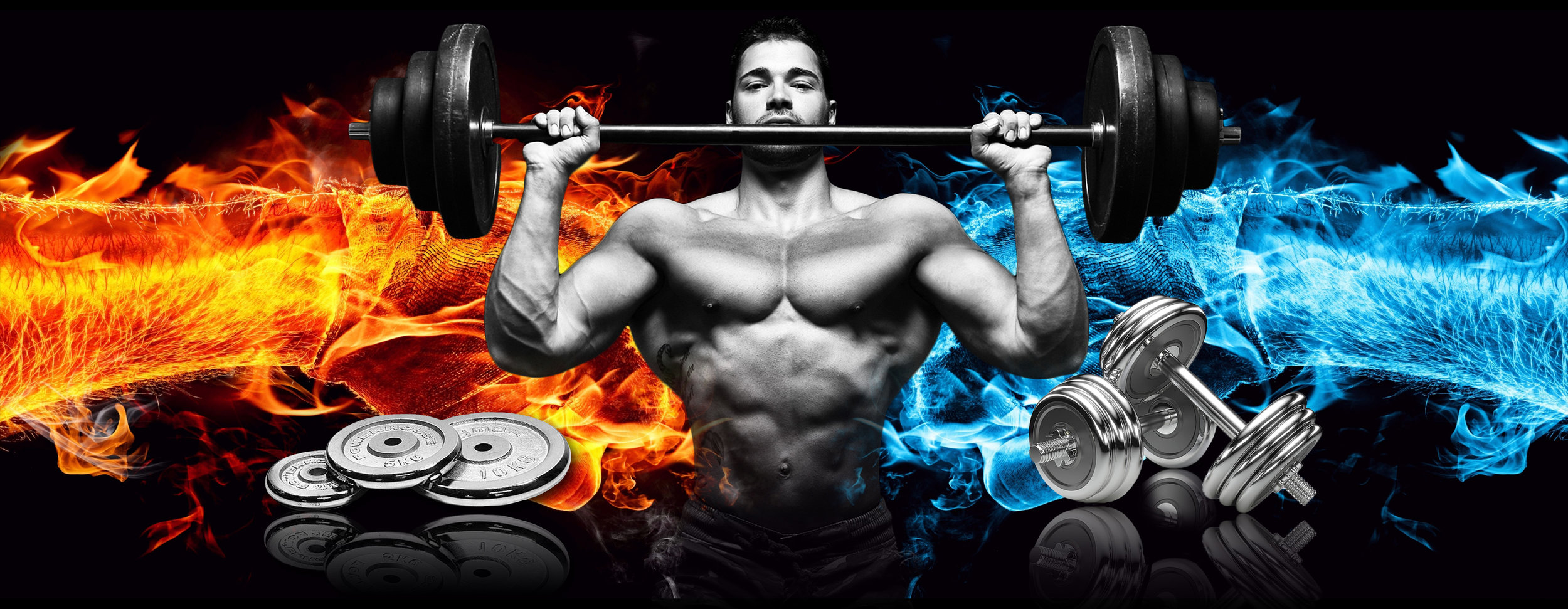Combine The Trap Bar & Landmine for Functional Strength and Size
Dr. Joel Seedman, Ph.D.
Two of my favorite strength training tools are the landmine and the trap bar. Not only are they incredibly versatile but they also provide numerous options that not only build functional strength and hypertrophy but oftentimes are more joint friendly than traditional barbell movements. Fortunately these two training tools can be combined to produce some incredibly potent exercises and movement variations that tax the entire body.
And on a side note, all of these exercises can be performed with traditional landmine stations anchored to the floor rather than on a rack. The effect will be nearly identical although elevating it 6-12 inches above the floor provides slightly greater range of motion and tension.
Here’s how to combine the landmine and trap bar on a number of movement patterns and drills.
Trap Bar Landmine Leg Exercises
The number of potential lower body exercises that can be applied to the trap bar landmine method is almost limitless. In fact the trap bar landmine setup can be incorporated on squats, deadlifts, hip hinges, kickstand variations, single leg variations, lunges, jumps and more. Here I have some of my pro athletes and clients demonstrating 10 of my go-to variations.
Performing single arm suitcase deadlifts and squats (by holding the trap bar handle to the sides of the body) not only stresses the lower body and core but it also requires intense anti-rotation and anti-lateral flexion components. As a result the core and abdominals get absolutely pulverized similar to a single arm plank or Pallof press. They’re also quite joint friendly as the lifter will be unable to handle the same loads he or she would typically use on deadlifts and squats however the stimulus to the entire lower body and core is quite intense.
Additionally, whichever arm is holding the load, that side of the lower body also receives much greater stress than the others (particularly in the glutes) providing a sort of single leg or offset loading protocol. This helps eliminate a number of imbalances and asymmetries in the body as one side will inevitably be significantly weaker. As an added bonus your grip and forearms will get torched from any of the single arm variations as you’ll be required to squeeze the daylights out of the handle to keep the trap bar from twisting, shifting, and rotating.
Using the landmine trap bar setup to perform longitudinal squats and deadlifts (holding the side bars of the trap bar instead of the trap bar handles) also provides a unique and effective method for targeting the legs with a more traditional movement pattern. Facing towards the landmine anchor produces slightly greater stress to the quads as it’s a slightly more upright position. Facing away from the anchor point produces greater tension to the posterior chain although both variations produce intense stress to the entire lower body
Lunges and split squats can also be performed in 3 different ways. This includes the two longitudinal trap bar methods (facing towards the anchor/pivot point and facing away from it) as well as the suitcase side loading method. Similar to the squats, the longitudinal methods will either target the posterior chain (facing away from the anchor point) or quads (facing towards the anchor point). Additionally, the suitcase side loading can be used to target the inner or outer thighs of the front leg as well as the ankle stabilizers.
If the movement is loaded contralaterally then the outer hips and abductors will get crushed. Additionally this produces a form of valgus and pronation forces on the knees and ankles that the lifter must resist which does wonders for correcting valgus collapse and ankle pronation. Ipsilateral loading on the other hand targets the inner thighs to a greater extent as the load is wanting to externally rotate the hips and pull the knee laterally. The balance is quite tricky on any of the lunges not only because of the offset loading but also because of the volatile rotational nature of the landmine particularly when combined with the more obtuse trap bar.
Lastly single leg squads and RDL’s can also be used. Just be prepare to stabilize and balance your body to another level as the difficulty of these is through the roof. Fortunately the single leg variations can be regressed by performing the movements in a kickstand fashion as shown in the video.
Trap Bar Landmine Rows
Last year I posted an article on the trap bar landmine row and it caught on like wildfire (read more about the landmine trap bar row here). Fortunately there are several additional variations that can be used by combining the trap bar and landmine. Here are 5 of my favorite variations as demonstrated by NFL cornerback Prince Iworah, NFL quarterback Taylor Heinicke, NPC figure competitor Leslie Petch, and beastly Viking Todd Weiland.
The single arm trap bar landmine row as I demonstrate in the first clip not only crushes the lats and upper back but the pronated grip along with the mediolateral instability of the trap bar (it wants to twist and rotate in the hands) also taxes the shoulder stabilizers. As a result it literally forces the lifter to use rock solid rowing mechanics and minimize excessive momentum. The split stance trap bar landmine row provides a unique way to crush the upper back and lats as well as the entire posterior chain and glutes. It also requires a significant degree of balance and stability making this an effective strength and motor control movement.
The renegade row demonstrated by Leslie is surprisingly intense as the rotational forces and unique leverage produced from the combination of the landmine and the trap bar produces enormous tension on the entire core as well as the upper back and lats.
The single arm suitcase bent over row not only isolates the daylights out of the upper back and lats but it also works the entire core particularly the obliques. That’s because the trap bar landmine setup produces intense lateral flexion forces and rotational forces on the spine that the lifter must resist throughout the set.
Here's another unique version of the suitcase rowing using a split stance setup as demonstrated by my bodybuilding athlete Ben Lai. Besides crushing the entire posterior chain including the glutes and hamstrings, the arching nature of the landmine bar path combined with the neutral grip encourages wrapping the elbow around toward the middle of the back, operating directly in line with pennation angle of the lats.
Chest Presses & Shoulder Presses with Landmine Trap Bar
The trap bar landmine setup can just as easily be applied to upper body presses as it can to rows and lower body movements. Here I’m demonstrating several variations alongside my awesome client Todd Weiland.
In the first clipp Todd is performing a single arm anti-rotation chest press. Besides crushing the pectorals as well as the shoulders and triceps, the level of core stability and abdominal activation is through the roof as the combination of unilateral loading combined with the arching path and rotational nature of the trap bar landmine setup makes these absolutely brutal on the core not to mention the shoulder stabilizers.
The second variation you’ll notice I’m performing a close v-grip chest press. This provides literally the same hand positioning as a traditional football bar or Swiss bar only you’re using the landmine station which has a very natural arching path making these incredibly shoulder friendly. However the stimulus to the upper body pressing muscles particularly the chest and triceps is inordinately high. The trap bar landmine setup is also surprisingly sensitive to asymmetrical loading as the bar will have a tendency to twist and rotate if the lifter favors one side. Just make sure to use 25 pound plates to allow a full ROM. In fact this exact setup literally forces the lifter to stop at exactly 90 degrees similar to a board press. Again this does wonders not only for maintaining constant tension on the targeted musculature but also for providing a very joint friendly and functional horizontal pressing exercise.
The third pressing exercise in the video is the pronated overhead trap bar landmine press. This vertical pressing exercise provides a very unique stimulus in that it’s literally one of the only methods that allows unilateral overhead pressing with a pronated/overhand grip. Although a neutral grip during landmine presses and most overhead presses is my go-to grip position (as it’s typically easier to pack the shoulders), periodically using a pronated grip actually has better transfer and carryover to overhead barbell presses and overhead Olympic lifting variations.
Additionally this landmine trap bar setup is unusually unstable and volatile as the trap bar literally wants to twist and shift in the hands unless proper technique, alignment, force vectors, and body mechanics are employed. Kneeling closer to the anchor/pivot point of the landmine is also more demanding in terms of leverage. Additionally the position is significantly more upright than a traditional landmine press producing even greater tension on the shoulders while still providing just enough of an angle to allow ample shoulder packing and centration of the glenohumeral joint.
Trap Bar Landmine Ab Rollouts and Core Exercises
If you’re looking for a unique way to spice up your ab rollout variations then try these Trap Bar landmine rollout variations as demonstrated by NFL athlete Marquell Beckwith and national figure competitor Leslie Petch.
Besides crushing the abs via anti-extension, the landmine provides a form of rotational forces and lateral flexion forces the lifter must resist thereby producing intense activation in the obliques, transverse abs, and quadratus lumborum.
Additionally, the neutral grip provided by the trap bar is also very conducive for locking the shoulders in and packing them into a very safe and stable position. You're also at a biomechanical disadvantage since you're closer to the pivot point (in comparison to a straight bar) therefore the demanding leverage position further increases the stimulus of the abdominals and core. These literally torch every muscle fiber from head to toe particularly when performed in a single leg or single arm fashion. And yes, these are every bit as difficult as they look.
If you’re looking for a program that teaches you how to incorporate unique exercises such as these trap bar landmine movements into your routine, check out my Complete Templates Series.











































